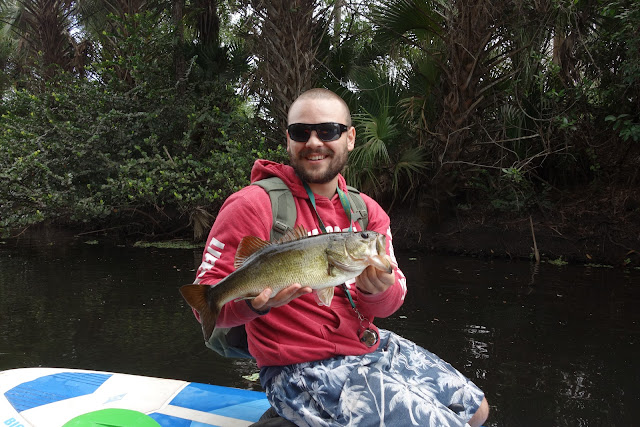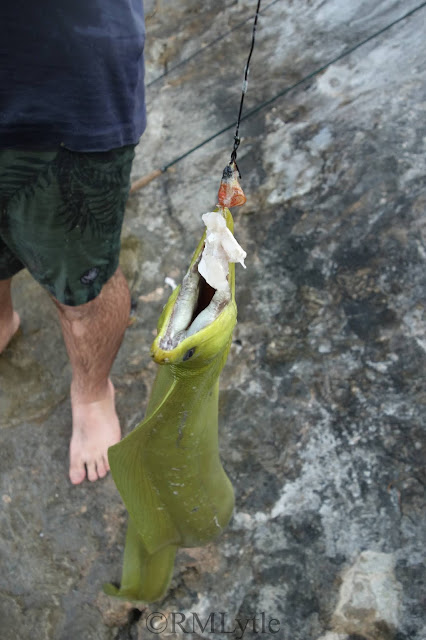Freshwater fishing in South Florida is game made tricky by spotty access, angry property owners, and overly abundant water. There's a lot of water that, to the untrained eye looks good, but doesn't actually hold much in the way of fish. Having a kayak or SUP is hugely advantageous as you are no longer bound to what minimal shore access exists but can travel freely throughout a canal system. That still doesn't mean you'll catch what you are looking for, but it does put you in a better position to do so. This is one of the numerous reasons Noah and I don't fly to Florida. We have more range and freedom.
Working our way south to where we'd spend the next two nights, Noah and I decided to fish the same canal system we were just on a day prior. It seemed like the best option and was on the way regardless. Noah's first fish proved our choice to be a good one.
Mine wasn't half bad either. This may be the same bull bluegill I caught in the same spot days before, I'm not sure. If it was, I didn't even mind. This has to be the best looking bluegill I've ever seen.
Upriver, I caught a less common species for as far north as we were... an oscar. It pounded a gurgler, which was pretty sweet. They've also got most freshwater fish beat fight wise, pound for pound. Unfortunately, aside from a few un-notable catches, there wasn't much else to report from that foray. There were a bunch of people fishing the spillway, and a canoe headed down while we were headed up told us they'd been catching small snook. They weren't when we got there, not anymore. We headed back down a little disgruntled, but having caught a handful of quality fish.
The next day, we were further south, in an area with even more diversity of freshwater invasives. Snakeheads, peacock bass, midas cichlids, and perhaps most excitingly, clown knifefish were to be our targets, and without our water crafts, we'd be hard pressed to find any that would be willing. Unfortunately the weather was not at all ideal, but we'd give it our all anyway.
Clown knifes roll, almost like tarpon or bowfin. I didn't think they'd hold to structure really, and that proved true. Peacock bass and snakeheads though would be holding onto their preferred structure. Weed beds for snakeheads, culverts expelling water for peacocks.
Noah got a blowup on a buzz toad that was almost certainly a snakehead, then I got a blast on an as of yet unnamed topwater pattern that may have been a snake as well. Further down the canal though, seeing a fair number of rolling clown knifes, I changed to a subsurface pattern.
I've never seen a single photograph or video of a clown knifefish caught on the fly. Given how inclined most flyfisherman (fisherman in general, really) to not think outside the box, I had perhaps too much confidence that I could convince one to eat. But, uh...
I made five casts in the vicinity of rolling clowns, and had one follow. I went the entire rest of the day without a single look from one, but I don't know jack about this species, really, and I convinced one to move on a fly first try. So this is something I am going to do. I have a game plan, I know some people, and I'm a little more determined than your average angler. Watch out clown knifefish. I'm coming for you.
Though we caught very little on this long paddle into unknown waters, it was a valuable experience and really illustrated the overall difficulty of finding freshwater fish in Florida if you don't know where to look. Most of the water we covered in these canals was essentially barren, with little in the way of structure for fish to hold to. When we found what little good structure there was, we found fish. I caught my first peacock bass in more than three years that day, and that was nice. Where I caught it was among only five places with notable concentrations of fish in legitimately miles of canal paddled. On foot? We'd almost certainly have done very poorly.
Until next time,
Fish for the love of fish.
Fish for the love of places fish live.
Fish for you.
And stay safe and healthy.
Thank you to my Patrons; Erin, David, John, Elizabeth, Brandon, Christopher, Shawn, Mike, Sara, Leo, and Franky for supporting this blog on Patreon.





















































